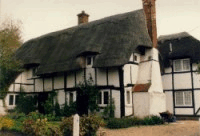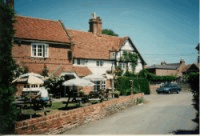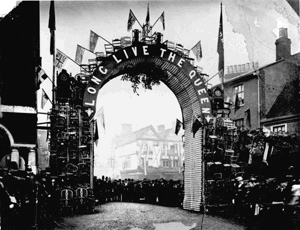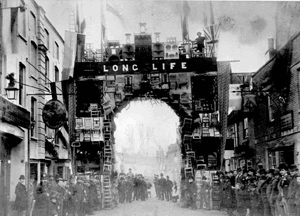|
|
|
Local History
Buildings
 The pattern of historic developments is traditionally
one of small villages and hamlets scattered across the Chiltern Hills, along the River Thames in the south, and in the north across the flat clay lands of the Vale
of Aylesbury. The three historic towns of the District have very contrasting natures, the smallest being Princes Risborough on the Chiltern scarp, Marlow
on the River Thames and High Wycombe. The latter two have Victorian and Edwardian expansions of considerable historic interest. The pattern of historic developments is traditionally
one of small villages and hamlets scattered across the Chiltern Hills, along the River Thames in the south, and in the north across the flat clay lands of the Vale
of Aylesbury. The three historic towns of the District have very contrasting natures, the smallest being Princes Risborough on the Chiltern scarp, Marlow
on the River Thames and High Wycombe. The latter two have Victorian and Edwardian expansions of considerable historic interest.
Wycombes industrial heritage is based on the wooded Chilterns, which provided timber, and the River Wye, which provided water for its numerous watermills. This
led to, in particular the furniture industry, and paper making. The architectural evidence for this remains, and some, such as the cane and rush works in High
Wycombe, are still in use.
 The bulk of the District is covered by the Chiltern
range of chalk hills, which rise to over 250 metres at Coombe Hill. The Vale of Aylesbury to the north is flat clay lands. The Chilterns provide much of the
local vernacular building materials that characterise the District. The relatively limited palette of traditional and vernacular materials adds to the
historic architectural character of the District. Red brick, until recently locally produced, flint from the chalk, and timber framing with
rendered or brick infill panels are the predominant building materials, while roofs are
thatched or plain clay tiles. Slate was extensively used from the mid 19th century
onwards, while stone, including locally quarried Denner Hill and chalk stone, and
imported limestones such a Bath or Ham Hill is found. Churches are usually small and
in local materials such as flint with imported freestone or local chalk stone dressings.
Larger houses and churches tend to be in higher quality imported stone and often have lead roofs. This range of materials contributes greatly to establishing local
character. The bulk of the District is covered by the Chiltern
range of chalk hills, which rise to over 250 metres at Coombe Hill. The Vale of Aylesbury to the north is flat clay lands. The Chilterns provide much of the
local vernacular building materials that characterise the District. The relatively limited palette of traditional and vernacular materials adds to the
historic architectural character of the District. Red brick, until recently locally produced, flint from the chalk, and timber framing with
rendered or brick infill panels are the predominant building materials, while roofs are
thatched or plain clay tiles. Slate was extensively used from the mid 19th century
onwards, while stone, including locally quarried Denner Hill and chalk stone, and
imported limestones such a Bath or Ham Hill is found. Churches are usually small and
in local materials such as flint with imported freestone or local chalk stone dressings.
Larger houses and churches tend to be in higher quality imported stone and often have lead roofs. This range of materials contributes greatly to establishing local
character.
The Districts towns and villages character largely derives from the surviving mixture of
historic buildings. In the countryside historic farm groupings retain links with
settlement patterns dating back many centuries while country houses are important elements in our social and economic history.
|
|
|
|
Chair Arch History
The Arch Tradition
Many towns in Victorian Britain constructed arches to mark special occasions, often composed of objects which
symbolised the town, like High Wycombes chairs. However, the origins of this tradition are unknown. None is earlier than the mid 1800s,
so it may be that towns around the country got the idea when Londons Marble Arch was moved from Buckingham Palace to Hyde Park Corner
in 1850-51.
Chair Arches in High Wycombe
The first known chair arch was put up in 1877 to mark a visit Queen Victoria paid
to Disraeli at Hughenden Manor. The idea originated with the Council, who deputed one of its members, Walter Skull, to organise it through
the Chair Manufacturers Association. He assembled a Committee which included some of the towns most notable chair masters, including
Benjamin Howland and Thomas Glenister.At the bottom were common Windsor and cane-seated chairs, rising with the ascent of the arch
through drawing-room, lounge, library, reading, rocking and other seats, to the State chair of the Mayor, covered with red velvet and
bearing the gilded crest of the Borough¦This arch attracted great admiration from Her Majesty as she returned from Hughenden, and had the
coach stopped to enable her to carefully examine it. (The Cabinet Maker & Complete House Furnisher, Nov 6 1915).

The largest chair arch contained about 400 chairs, and was erected at the Guildhall
in 1884 to mark the visit of the Prince of Wales.
West Wycombe Chair makers put up an arch across the High Street outside the
George & Dragon in 1889 to celebrate the return of Sir Edwin Dashwood from New Zealand.

There is no evidence of any other full-scale chair arches being erected. Several
other commemorative arches were built in and around High Wycombe in the 1800s and early 1900s but these did not include chairs.
However there was an arch of modern chairs put up inside the Town Hall for the visit of the Queen in 1962.
Arch Tribute To Furniture Makers
Hundreds of people celebrated a historic event recently in High Wycombe with the
official opening of the Millennium Chair arch. Built as a tribute to the town's famous
furniture industry, this modern chair arch recreated the structure built for a royal visit
110 years ago. Spanning the end of the High Street near the Guildhall, the arch was made up of over 200 chairs and is more than 9.5m tall.
|
|
|
|
|
|
|